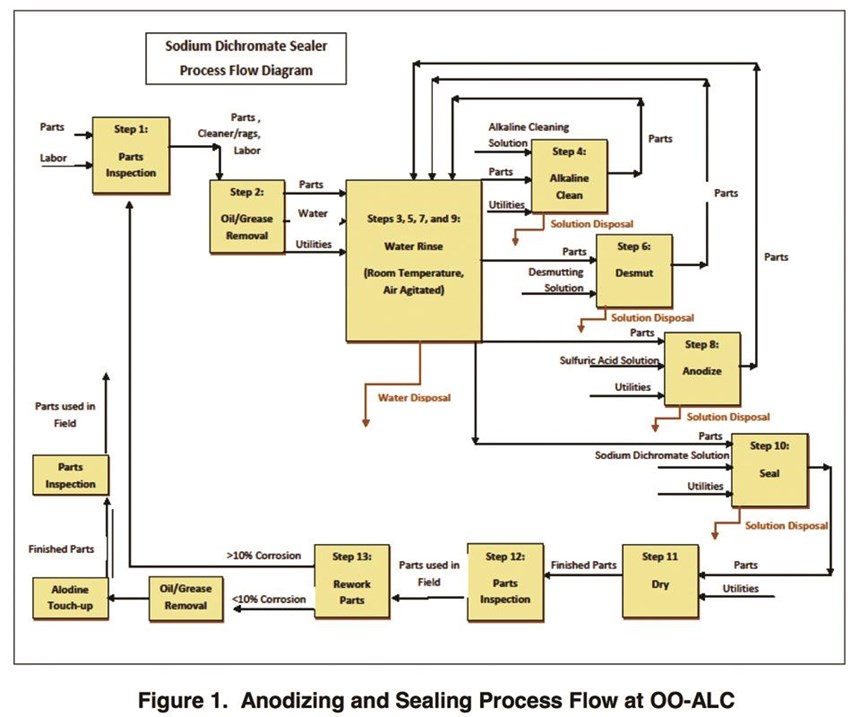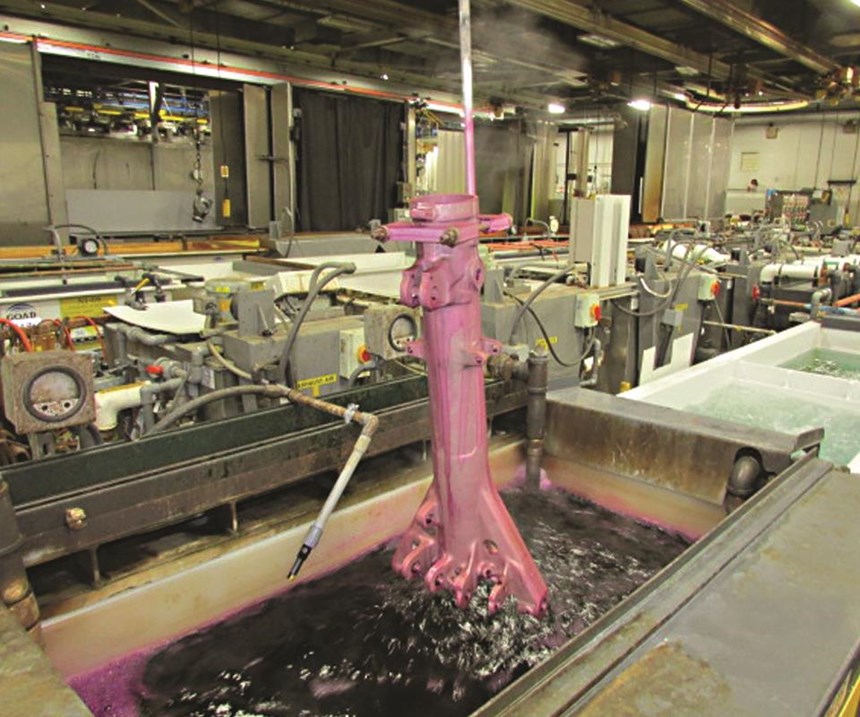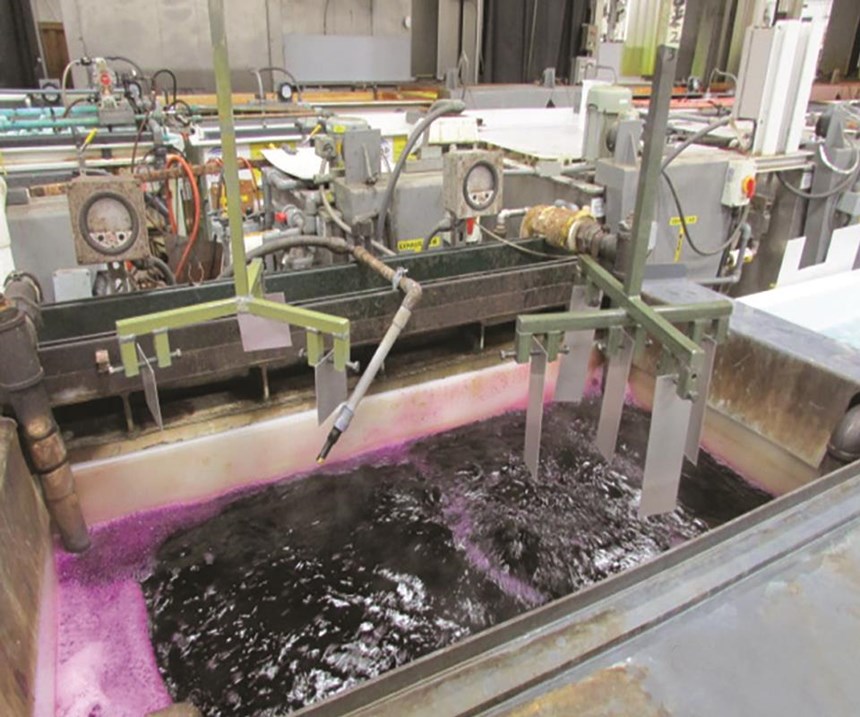Reducing Hexavalent Chromium in Military Anodizing Operations
How U.S. Air Force facilities transitioned a dichromate sealer replacement.
Ogden Air Logistics Complex (OO-ALC) in Ogden, Utah, is the primary facility within the U.S. Air Force (USAF) for maintaining and overhauling aircraft landing gear. Aluminum landing gear components are anodized at OO-ALC to provide wear- and corrosion-resistant surfaces, and a sealing operation completes the anodizing process. During this operation, the pores of the anodized (oxide) layer become hydrated, thereby increasing the volume, filling the pores, and subsequently improving corrosion and staining resistance.
At OO-ALC, a sodium dichromate sealer (DCS) is used for the sealing process. While this sealer has been effective for many years, it contains hexavalent chromium (Cr6), which is listed as a hazardous air pollutant under the Clean Air Act and cited in numerous other regulations. As a result, the Occupational Safety and Health Administration lowered its worker exposure limit for Cr6 in 2006 from 52 micrograms per cubic meter of air (µg/cm3) to 5 µg/cm3. Further, the U.S. Department of Defense (DoD) issued a directive in 2009 that restricts the use of Cr6 on military vehicles and weapon systems.
Based on these concerns, the USAF needed to identify, validate and implement a chromium-free sealer to reduce the use of Cr6 in anodizing operations. MIL-A-8625, which outlines both the anodizing and DCS sealing process, provides for alternative, non-Cr6 sealing processes, however there is insufficient data to promote the use of these Cr6-free processes at OO-ALC.
To address this issue and identify other viable alternatives, the Air Force Research Laboratory (AFRL) tasked its consultants with conducting a dichromate sealer replacement project to identify, evaluate and implement DCS alternatives for anodizing operations at OO-ALC.
Under the initial stages of this effort, the project team identified two baselines and a benchmark, as well as two viable, commercial off-the-shelf (COTS) chromium-free alternatives: one based on potassium permanganate and a second based on nickel acetate. These candidates were identified through prior work, literature searches, vendor inquiries and industry surveys. The team conducted screening tests on the candidates to assess their ability to comply with MIL-A-8625, and the results revealed that the COTS permanganate sealer met all of the acceptance criteria for an alternative to DCS.
In addition, a cost-benefit analysis showed that processing costs with the alternative would be nearly the same as the DCS baseline, with additional qualitative benefits for the COTS permanganate alternative due to significant environmental health and safety improvements. Based on both positive technical results and a promising business case, the OO-ALC Engineering Review Board (ERB) reviewed the data and approved the COTS permanganate sealer for implementation at OO-ALC with chromated primers.
However, during the course of the effort, OO-ALC also implemented Cr6-free primers in combination with Cr6-based pretreatments, specifically DCS.
Therefore, OO-ALC requested that additional testing be conducted to ensure that overall engineering performance is not affected by applying the COTS permanganate sealer in combination with a Cr6-free primer. In addition, OO-ALC requested testing to ensure that no issues are experienced when the COTS permanganate sealer is applied over a re-anodized surface (such as when applied over an abraded, previously DCS anodized coating). An assessment of performance with Cr6-free primers, as well as a rework assessment on Type II anodized/DCS panels, was conducted. The COTS permanganate sealer passed thickness and corrosion resistance in both standard and rework scenarios (outlined above in Figure 1). It was determined that the process met OO-ALC repair requirements and was still a viable candidate to replace the DCS for Type II anodizing operations at OO-ALC.
As final assurance that the process would work well at OO-ALC, confirmation testing was performed to ensure that the performance of the COTS permanganate sealer would meet OO-ALC requirements for anodize sealing applications when subsequently painted with both Cr6-based and Cr6-free primers.
Primers included two Cr6-free primers; the baselines were two chromated primers. The resulting corrosion performance of panels sealed with the COTS permanganate sealer met or exceeded the corrosion performance of their counterparts sealed with DCS, with only two exceptions. In those two cases, the specimens still performed within applicable military specifications.
Installation, Transition Planning
As a result of successful testing, the project team recommended the COTS permanganate sealer process be implemented at OO-ALC and used in concert with qualified Cr6-free primers. The consultants worked with representatives from OO-ALC’s 417th Landing Gear Engineering Group and 309th Process Engineering Group to obtain approval to transition the COTS permanganate sealer to the 309th Process Engineering Group. To facilitate the implementation of the COTS permanganate sealer at OO-ALC, the project team developed an implementation checklist to ensure all necessary items related to the installation were addressed.
OO-ALC has two anodizing lines, hereafter referred to as the Large Anodizing Line (which employs larger tanks for the large volume of wheels processed) and the Small Anodizing Line (primarily for brake and strut components, which are lower in volume). Both are configured as follows:
- Immersion in alkaline detergent, 140–160°F (60–70°C) for 1–5 min.
- Cold water rinse
- 30-second etch
- Cold water rinse
- Deoxidize for 1–2 min. at 120–130°F (49–54°C)
- Cold water rinse, verify water-break-free surface
- Type II (sulfuric acid) anodizing solution at 64–72°F. Current applied until voltage reaches 18 volts (approx. 40 amps), maintain for 20–30 min.
- Cold water rinse
For sealing, OO-ALC determined that DCS will remain in the sealing tank in the Large Line temporarily, while the sealing tank in the Small Line was designated for conversion to the COTS permanganate sealer. The DCS tank is operated at approximately 212°F, and parts are processed in the sealer for about 20 minutes. Conversely, the COTS permanganate sealer is operated at about 170°F for 12 to 15 minutes. In either case, after sealing, parts proceed to a cold water rinse and then a hot water rinse. Finally, parts are dried with shop air operated at room temperature.
Tank Liner Procurement
Upon reviewing the process flow at OO-ALC, the tank layout and the chemicals needed to charge the sealing tank in the Small Line, the project team determined the COTS permanganate sealer would be incompatible with the existing stainless steel tank, due to the Cr6 contamination that would remain from the DCS. Upon review by the 309th Process Engineering Group, OO-ALC established a requirement that a solid liner, fabricated in place, would be needed for the tank to accommodate the new process. A subcontractor was hired to fabricate and install the solid liners. The 309th Process Engineering Group conveyed tank dimensions of 66 inches long by 36 inches wide by 130-½ inches deep. The project team worked with OO-ALC to confirm and finalize the necessary tank dimensions because the liner would be rigid and would need to fit in the existing tank precisely. This confirmation included the difficult task of obtaining the necessary bottom tank slope information. It was determined that a flat-bottomed tank would be more suitable for this process and that it would be appropriate to fill the sloping bottom of the existing stainless steel tank with sand prior to installing the liner. The subcontractor manufactured the tank from ½-inch-thick natural stress-relieved polypropylene.
Document Modifications
To support the rapid transition of the COTS permangante sealer, the team supported OO-ALC in updating all applicable documents related to anodizing and sealing at the facility. OO-ALC determined that the use of the COTS permanganate sealer would impact three technical orders (TOs) related to sealing of Type II anodizing. The team supported OO-ALC’s effort to update these TOs accordingly. In addition to the TOs, OO-ALC process orders had to be modified to specify the COTS permanganate sealer. The project team provided edits, additions and inputs to these process orders. Finally, both OO-ALC and the project team determined the overarching military specification, MIL-A-8625, did not need to be updated to permit the use of the COTS permanganate sealer.
Liner Installation, Chemistry Charging
The subcontractor filled the bottom of the V-shaped tank with sand to fully support the liner and its intended contents, and installed the liner. OO-ALC then leached the liner with sulfuric acid for two days. Afterwards, the sulfuric acid was pumped out, the liner was rinsed with water and hydrochloric acid was pumped into the tank and left standing for two days. The hydrochloric acid leach was introduced to remove scale from the existing tank pipes and hardware. After two days, the hydrochloric acid was pumped out and the tank was washed with water again. Eleven days later, OO-ALC personnel charged the sealing tank with the COTS permanganate chemistry. The tank was mixed with air agitation but was not heated until project team members arrived the next day to process panels and parts.
Processing Panels
The project team worked with OO-ALC plating personnel to anodize and subsequently seal panels and parts. The project team conducted three runs. The first run was test panels made from 2024 Al alloy. These panels were pretreated, anodized and sealed with the COTS permanganate sealer on the Small Line. The appearance of the panels as they went into the COTS permanganate sealer is shown in Figure 3. These panels were subsequently placed in the salt spray chamber at OO-ALC for 336 hours, in accordance with MIL-A-8625 [Ref. 1], as part of qualification for the COTS permanganate sealer. A second run involved the processing of a scrap part, specifically a large F-15 outer piston made from 7075 aluminum alloy (see Figure 2). Due to production schedules, the part was pretreated on the Large Line, and anodized and sealed on the Small Line. The third run involved additional 2024 panels. These panels were also pretreated on the Large Line and anodized and sealed on the Small Line.
Less than two months later, OO-ALC reported all of the tested panels passed the 336-hour B117 requirement and the COTS permanganate sealer was approved.
Summary and Recommendations
Through extensive testing, the project team demonstrated that the COTS permanganate sealer met all requirements for the sealing of Type II anodized aluminum parts at OO-ALC. Anodized parts sealed with this sealer met requirements when painted with either chromium-containing or chromium-free primers, matching or exceeding the adhesion and corrosion-protection performance of DCS in nearly all scenarios. The COTS permanganate sealer performed similarly to DCS for both new parts and reworked parts and met the requirements of the relevant military specifications. Due to the successful results, the COTS permanganate sealer process was installed in the 1,269-gallon sealing tank on the Small Line.
Recognizing that OO-ALC intends to implement a chromium-free anodizing operation to incorporate a completely chromium-free coating system, these positive findings led to the recommendation that the COTS permanganate sealer be fully implemented at OO-ALC used in concert with qualified chromium-free primers. It is further recommended that the successful results of this effort be leveraged to demonstrate non-chromium sealers for use in anodizing operations in other Air Force ALCs and other DoD maintenance operations. Specifically, the successful results of this effort can be leveraged for anodizing operations at both Oklahoma City ALC, Oklahoma, and Warner Robins ALC, Georgia.
Dr. Elizabeth Berman is with the Air Force Research Laboratory at Wright-Patterson Air Force Base in Dayton, Ohio. Robert B. Mason, Jr., CEF, PMP, is with Concurrent Technologies Corp. in Odessa, Florida.
Acknowledgements
This work was conducted under tasking by the AFRL EnviroTech contract. The authors would like to express thanks to Mr. Tom Naguy and Mr. David Madden of the USAF for their support of this work. Additionally, the authors would like to express thanks to Mr. Nathan Hughes and Mr. Mark Robeson of OO-ALC’s Process Engineering Group for their time and consideration in support of this effort. Goad Co. provided outstanding service in the fabrication and installation of the tank liner and its contribution to the success of this activity is greatly appreciated. Finally, the authors wish to recognize the significant contributions of Ms. Donna Provance, Ms. Sarah Clark, and Dr. Melissa Klingenberg, for not only their outstanding leadership but also their technical guidance and input to this effort.
References and End Notes
1. L. Hao and B. Cheng, “Sealing Processes of Anodic Coatings – Past, Present, and Future,” Metal Finishing, Elsevier Inc., New York, December 2000.
2. MIL-A-8625F, Military Specification, Anodic Coatings for Aluminum and Aluminum Alloys, Department of Defense, 15 September 2003.
3. R. Mason, S. Clark, M. Klingenberg, E. Berman, and N. Voevodin, “Alternatives to Dichromate Sealer in Anodizing Operations,” Metal Finishing, Elsevier Inc., New York, June 2011.
4. R. Mason, S. Clark, M. Klingenberg, E. Berman, and N. Voevodin, “Alternatives to Dichromate Sealer in Anodizing Operations,” 80th Universal Metal Finishing Guidebook, Elsevier Inc., New York, Fall 2012, Volume 110, number 9A, pages 372383.
5. R. Mason, S. Clark, M. Klingenberg, M. Miller, E. Berman, and N. Voevodin, “Type II Anodizing Operations: Test Results Hold Promise for Alternatives to Dichromate Sealer,” Metal Finishing, Elsevier Inc., New York, April 2012.
6. R. Mason, E. Berman, N. Voevodin, M. Klingenberg, and S. Clark, “Testing of Dichromate Sealer Replacements for U.S. Air Force Anodizing Operations,” SUR/FIN 2012, Las Vegas, NV, June 12, 2012.
7. R. Mason, E. Berman, E. Griesenbrock, M. Klingenberg, and H. Smith, “Corrosion Performance of Dichromate Sealer Replacement with Non-Chromium Primers for U.S. Air Force Anodizing Operations,” Fifth Annual Mid-Winter Finishers Conference, Orlando, FL, January 29, 2015.
8. R. Mason, E. Berman, and M. Klingenberg, “Testing of Dichromate Sealer Replacements for U.S. Air Force Anodizing Operations,” Proceedings of the 2015 Department of Defense – Allied Nations Technical Corrosion Conference, 2015.
9. R. Mason, E. Berman, and M. Klingenberg, “Testing of Dichromate Sealer Replacements for U.S. Air Force Anodizing Operations,” Sixth Annual Mid-Winter Finishers Conference, Cape Canaveral, FL, February 10, 2016.
Originally published in the February 2017 issue.
Related Content
Corrosion Protection Options for Aluminum
Seeking to understand aluminum corrosion and prevention? Jacob Weingart of Columbia Chemical offers a helpful overview of corrosion protection options for aluminum and its alloys.
Read MoreProducts Finishing Reveals 2024 Qualifying Top Shops
PF reveals the qualifying shops in its annual Top Shops Benchmarking Survey — a program designed to offer shops insights into their overall performance in the industry.
Read MoreUnderstanding and Managing White Spots on Anodized Aluminum
Having trouble with spotting defects when anodizing? Taj Patel of Techevon LLC offers a helpful overview of the various causes of white spots and potential solutions.
Read MoreChicago-Based Anodizer Doubles Capacity, Enhancing Technology
Chicago Anodizing Company recently completed a major renovation, increasing its capacity for hardcoat anodizing and Type II anodizing.
Read MoreRead Next
A ‘Clean’ Agenda Offers Unique Presentations in Chicago
The 2024 Parts Cleaning Conference, co-located with the International Manufacturing Technology Show, includes presentations by several speakers who are new to the conference and topics that have not been covered in past editions of this event.
Read MoreEpisode 45: An Interview with Chandler Mancuso, MacDermid Envio Solutions
Chandler Mancuso, technical director with MacDermid Envio discusses updating your wastewater treatment system and implementing materials recycling solutions to increase efficiencies, control costs and reduce environmental impact.
Read MoreDelivering Increased Benefits to Greenhouse Films
Baystar's Borstar technology is helping customers deliver better, more reliable production methods to greenhouse agriculture.
Read More

























